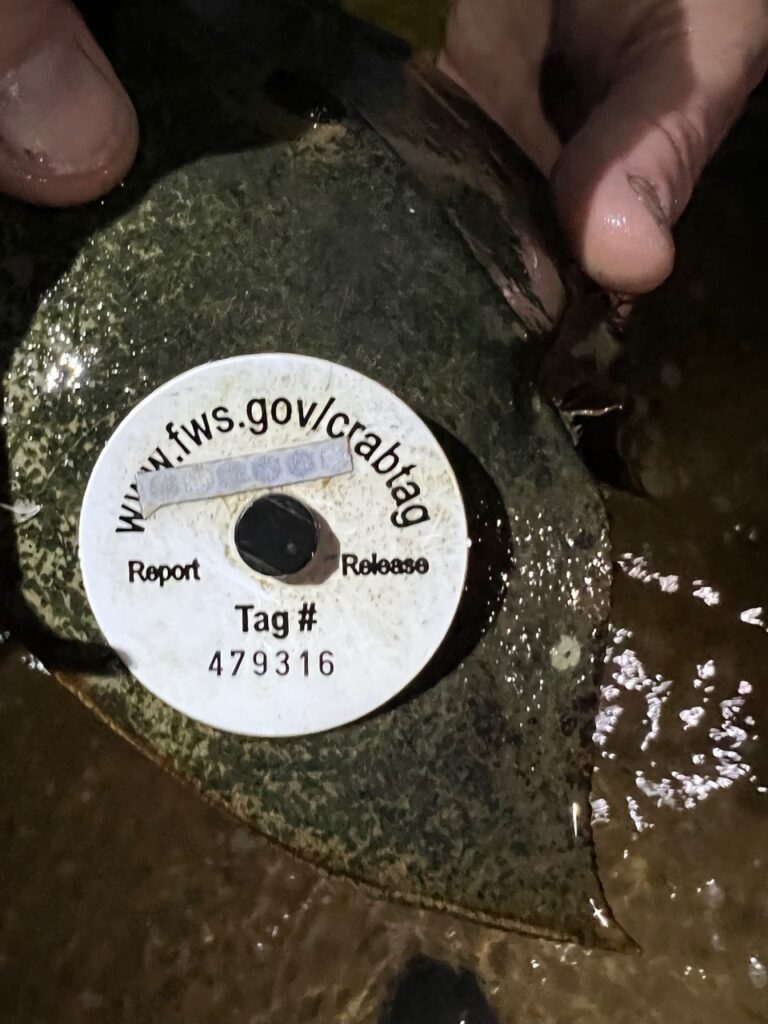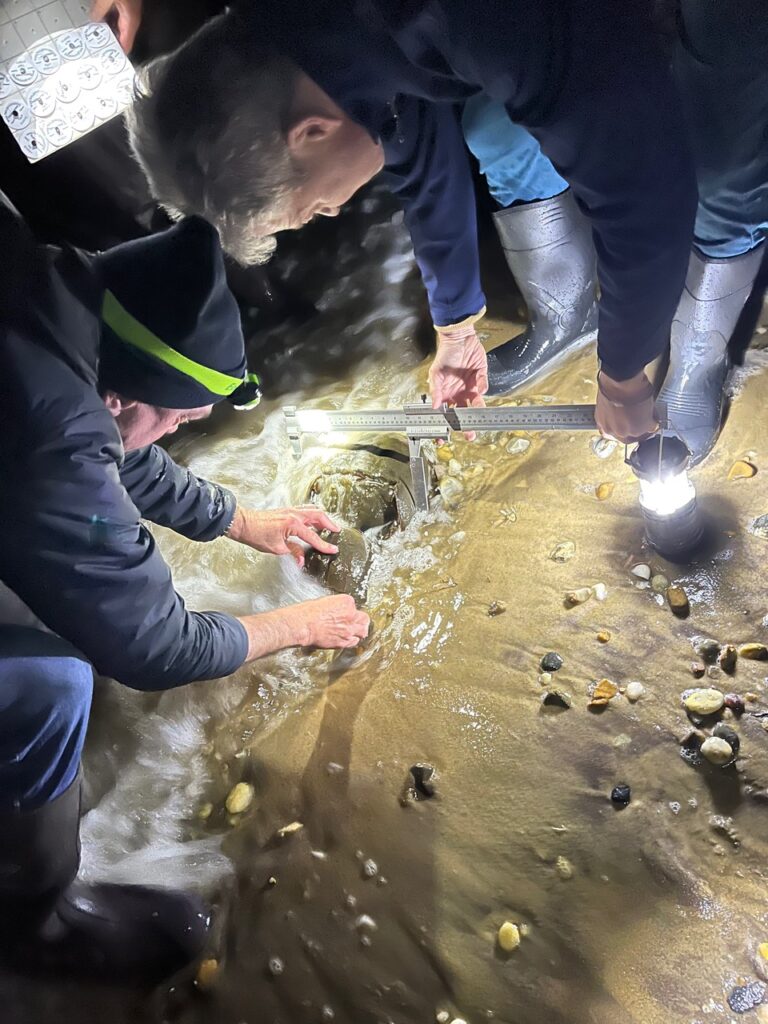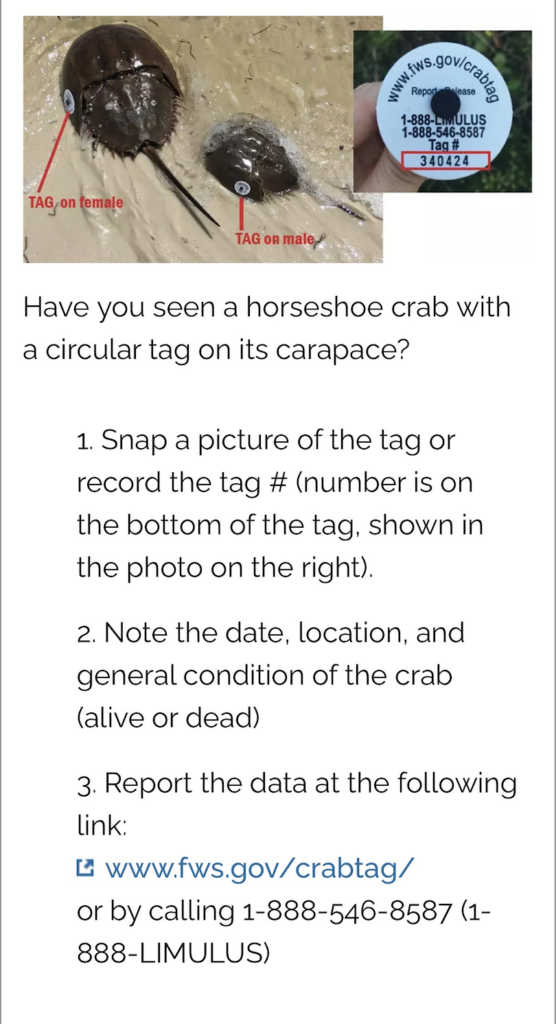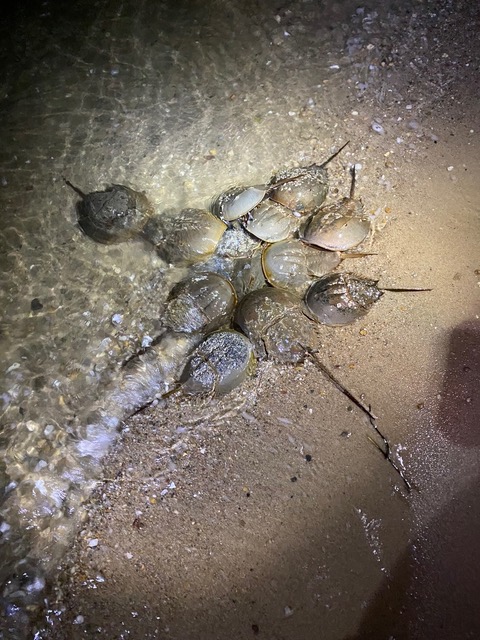
During the month of May, lead by Trustee Tim Garneau, the annual spawning season and surveying of horseshoe crabs began. May 3rd was the kickoff of the 2023 horseshoe crab spawning survey . (Full Moon -2) Deputy Clerk Jim Grimes, and Trustees John Aldred, and David Cataletto have also been collecting information, measuring and tagging the horseshoe crabs on our various beaches in East Hampton.
Provided by Cornell Extension Marine Program, here’s what goes into this important annual survey:
- Fill out ALL of the fields on the data forms.
- Take the offshore visibility measurement from the place you will be counting crabs, or from multiple places if it varies, if you are following the Total Count protocol.
- Walk a consistent path along the shoreline or slightly in the water while looking for crabs.
- Tag the animals in the correct location as shown in the attached image below (on their left side, behind the hinge, in the ‘triangle.’ It can be a little further forward toward the hinge as well).
- Make sure you record any recaptured tags you spot along the way, they are crucial to our tagging models.
- When tagging, please also record the shell condition category and % encrustment catagory information on the tagging datasheet as described in the attached file and during the site coordinator training workshop (see attached guide).
- Be safe and don’t take any unnecessary risks!

Florida Fish and WildlifeConservation Commission:
Facts About Horseshoe Crabs- DYK? Horseshoe crabs are not actually crabs at all, they are much more closely related to spiders and other arachnids than they are to crabs or lobsters! There are four species of horseshoe crabs still around today.
Horseshoe crabs are “living fossils” meaning they have existed nearly unchanged for at least 445 million years, well before even dinosaurs existed.
Only one species, Limulus polyphemus, is found in North America along the Atlantic and Gulf coasts from Maine to Mexico. The other three species are found in Southeast Asia.
Horseshoe crabs have a tank-like structure consisting of a front shell called the prosoma, a back shell called the opisthosoma, and a spike-like tail called a telson. Some people think horseshoe crabs are dangerous animals because they have sharp tails, but they are totally harmless. Really, horseshoe crabs are just clumsy and they use their tail to flip themselves back over if they get overturned by a wave.*
Though the horseshoe crab’s shell is hard, it is very sensitive to the world around it. The crabs are especially sensitive to light. They have 10 eyes, a pair of compound eyes on the prosoma, and “photo receptors” in other areas, primarily along the tail.
When mating, the smaller male crab hooks himself to the top of the larger female’s shell by using his specialized front claws, and together they crawl to the beach. The male fertilizes the eggs as the female lays them in a nest in the sand.
Some males (called satellite males) do not attach to females but still have success in fertilizing the female’s eggs by hanging around the attached pair. Most nesting activity takes place during high tides around the time of a new or full moon.
Horseshoe crab larvae emerge from their nests several weeks after the eggs are laid. Juvenile horseshoe crabs look a lot like adults except that their tails are smaller. The young and adult horseshoe crabs spend most of their time on the sandy bottoms of inter-tidal flats or zones above the low tide mark and feed on various invertebrates.
East Hampton Town Trustees coordinated horseshoe crab surveying and tagging this May.



Here’s a recap of May’s horseshoe crab monitoring cycle from NY Horseshoe Crab Monitoring Team Cornell Cooperative Extension Marine Program New York State Department of Environmental Conservation Stony Brook University School of Marine and Atmospheric Sciences.
May 17th: Is the first night of the second monitoring cycle (a New Moon cycle), and horseshoe crab counts are expected to be peak at many of our sites over the next few days, assuming that the current high winds dissipate later tonight. Some of our South Shore sites have been reporting counts in the thousands over the past cycle, and North Shore sites are starting to catch up as the water in the LI Sound warms.
May 19th: Tonight is the New Moon, and it should be a lovely evening to count and tag horseshoe crabs! Many of our sites are reporting high numbers of crabs this cycle, and several sites have already put out all of their tags for the season, which is wonderful news!
May 21st: Tonight is the last night of the second monitoring cycle (New Moon +2), and should be another great night to count and tag horseshoe crabs! Current weather predictions for this evening consist of clear skies, ~55-60°F air temperatures, and ~5mph NW winds across all of our sites.
***Just a note to please be on the lookout for recaptured tags, as the data that recaptures provide to us is extremely important to our research (and, according to folklore, finding and reporting a tagged horseshoe crab is also said to be very auspicious)!


New York Horseshoe Crab Monitoring Network– Cornell Cooperative Extension Marine Program-New York State Department of Environmental Conservation-Stony Brook University School of Marine and Atmospheric Sciences.
Are horseshoe crabs important to human beings and our health? Here’s a video from PBS – SCI NC to answer this question:
Why are horseshoe crabs important?
Horseshoe crabs are an important part of the ecology of coastal communities. Their eggs are the major food source for shorebirds migrating north, including the federally-threatened red knot. These shorebirds have evolved to time their migrations to coincide with peak horseshoe crab spawning activity, especially in the Delaware and Chesapeake Bay areas. They use these horseshoe crab beaches as a gas station, to fuel up and continue their journey.
Many fish species as well as birds feed on horseshoe crab eggs in Florida. Adult horseshoes serve as prey for sea turtles, alligators, horse conchs, and sharks.
Horseshoe crabs are also extremely important to the biomedical industry because their unique, copper-based blue blood contains a substance called “Limulus Amebocyte Lysate”, or “LAL”.
This compound coagulates or clumps up in the presence of small amounts of bacterial toxins and is used to test for sterility of medical equipment and virtually all injectable drugs. That way, when you get a vaccine you know it hasn’t been contaminated by any bacteria. Anyone who has had an injection, vaccination, or surgery has benefited from horseshoe crabs! Additionally, research on the amazing and complex compound eyes of horseshoe crabs has led to a better understanding of human vision.
Horseshoe crabs are also used in several fisheries. The marine life fishery collects live horseshoe crabs for resale as pets in aquariums, research subjects, or as educational specimens, and both the American eel and whelk fisheries use horseshoe crabs as bait along many parts of the Atlantic coast.
Threats to horseshoe crabs and research efforts
Horseshoe crab numbers are declining throughout much of their range. In 1998, The Atlantic States Marine Fisheries Commission developed a Horseshoe Crab Fishery Management Plan that requires all Atlantic coastal states to identify horseshoe crab nesting beaches.